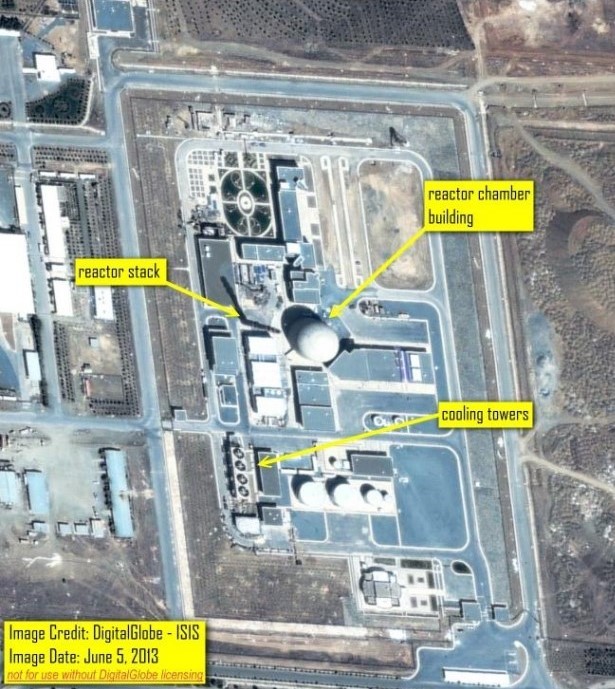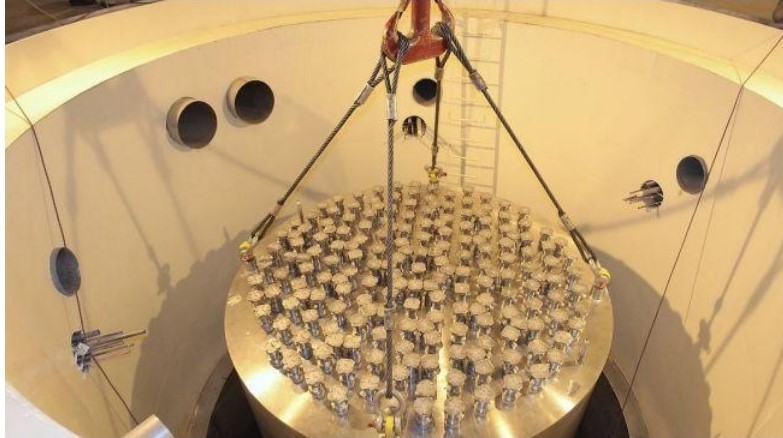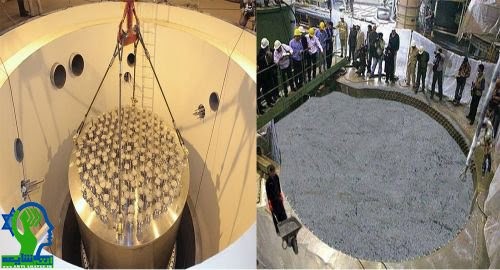Reports
Parsing Iran’s Claims about Quickly Reconstituting the IR-40: Are the Plutonium Pathway Restrictions Undermined?
by David Albright and Andrea Stricker
February 5, 2019
Recent comments by Iran’s Atomic Energy Organization (AEOI) head, Ali Akbar Salehi, raise questions about whether Iran has hidden equipment for the Arak reactor that should have been rendered unusable prior to the implementation of the Joint Comprehensive Plan of Action (JCPOA) in January 2016. His comments refer to Iranian actions before the nuclear deal went into effect that were designed to allow a speedy reconstitution of the original core of the IR-40 reactor at Arak, at least prior to its future operation. The original core design would allow the production of relatively large amounts of weapons-grade plutonium for nuclear weapons. Heading off this possibility was a special target of Western negotiators as part of their fundamental goal to block Iran’s plutonium pathway to nuclear weapons.
Under the JCPOA, Iran was required to render a key part of the reactor that holds the nuclear fuel, called the calandria, unusable in future nuclear applications. The calandria is a metal lattice that holds specialized tubes that contain the fuel assemblies. They allow heavy water to flow through them. This original calandria was designed to hold natural uranium fuel that could allow the reactor to be used to make weapon-grade plutonium, and the JCPOA developed an arrangement that would substitute this calandria with a new core design that would not function on natural uranium and thus could not produce significant amounts of weapon-grade plutonium.
As far as can be determined, the original calandria was filled with concrete and rendered inoperative in late 2015 or early 2016, prior to Implementation Day of the JCPOA. However, in an interview with Iran’s Channel 4 TV on January 22, 2019, Salehi stated that Iran had surreptitiously imported a second set of tubes for the IR-40 calandria in case the JCPOA parties reneged on their commitments, allowing Iran to more quickly reconstitute the reactor. Salehi stated, “There are tubes where the fuel goes [in the calandria]. We had bought similar tubes, but I could not declare this at the time. Only one person in Iran knew this. We told no one but the top man of the regime [Khamenei].” He continued, “We had bought the same quantity of similar tubes. When they told us to pour cement into the tubes… we said: ‘Fine. We will pour.’ But we did not tell them that we had other tubes. Otherwise, they would have told us to pour cement into those tubes as well. Now we have the same tubes.” This comment raises the question of whether Iran has built, or could quickly build, a duplicate calandria for the Arak reactor or another one that has not been declared by Iran.
The IAEA should clarify this situation. It should seek to find out the location of the tubes and their origin and whether Iran has built or intends to build a second calandria with the imported tubes. If it has not done so, the IAEA should insist on rendering these tubes unusable, whether or not in an assembled calandria. It should also ensure the absence of any undeclared reactor construction effort in Iran. It would be beneficial for public understanding if the IAEA described its actions to address this issue in its forthcoming Iran safeguards report.
Iran’s Plutonium Pathway to Nuclear Weapons
The IR-40 heavy water-moderated reactor, located near the city of Arak (now renamed the Khondab Heavy Water Research Reactor 1), was planned for operation in 2014 but never went critical (see Figure 1). Its advancement was suspended in 2013 under the interim Iran nuclear deal, the Joint Plan of Action (JPOA).2 The reactor was designed to produce 40 megawatts thermal (MWth) of power using natural uranium fuel produced at the Fuel Manufacturing Plant at Esfahan. The IR-40’s original calandria was scheduled for disablement and the entire reactor for re-design under the JCPOA due to its potential proliferation risk in providing Iran a pathway to a plutonium-based nuclear weapon. The reactor could have produced an estimated 9-10 kilograms of plutonium per year, or enough for about one to two nuclear weapons.3 Iran admitted to the IAEA early plans to build hot cells near the reactor, which could have been used for the separation of small amounts of plutonium, but stated it revised those plans in 2004.4 A photograph of the original IR-40 calandria, designed to hold natural uranium fuel, is in Figure 2.
Under the JCPOA, Iran committed the following regarding the IR-40 reactor:
Iran will not pursue construction at the existing unfinished reactor based on its original design and will remove the existing calandria and retain it in Iran. The calandria will be made inoperable by filling any openings in the calandria with concrete such that the IAEA can verify that it will not be usable for a future nuclear application. In redesigning and reconstructing of the modernized Arak heavy water research reactor, Iran will maximise the use of existing infrastructure already installed at the current Arak research reactor.5
Iran also committed to a series of technical constraints and specifications in an Attachment to the JCPOA entitled “Arak conceptual design.” In short, the IR-40 would be transferred to hold far less fuel using a new calandria with fewer tubes; it would be re-piped and would run on low enriched uranium. It would still use heavy water as a moderator. These measures would stop the production of significant amounts of weapon-grade plutonium, reduce the total amount of lower quality plutonium produced in the fuel, and make chemical separation of this plutonium from the irradiated fuel extremely difficult, but they would allow Iran to continue producing radio-isotopes for medical uses. Iran also committed to ship any spent fuel out of the country for the life of the reactor to further reduce the chance that non-weapon-grade plutonium could be recovered and misused. Iran also committed not to build any heavy water nuclear reactors for fifteen years or to separate plutonium during that time. The project to re-design the core of the Arak reactor has been underway and is overseen by China.
Disabling the IR-40
On January 11, 2016, Iran state media released reports that Tehran had removed the IR-40’s original calandria from the core of the reactor. Iranian officials stated that the reactor calandria’s “cavities, and not its heart” had been filled with cement and the IAEA would verify the action. It is our understanding that the IAEA was present to oversee this disablement process in real time and witnessed the cementing of the calandria’s tubes.
In its January 16, 2016 Implementation Day report on the status of verification and monitoring in Iran in light of United Nations Security Council Resolution 2231 (the resolution that codified the JCPOA), the IAEA stated the following: Iran “removed the existing calandria from the IR-40 Reactor,” and “rendered the calandria inoperable by filling the openings in it with concrete, such that the Agency was able to verify that the calandria is not usable for a future nuclear application.” On January 16, former President Barack Obama iterated at a press conference, “Today, the core of that reactor has been pulled out and filled with concrete, so it cannot be used again.”
The calandria sits in a larger reactor pit or core (surrounded by what is sometimes called the “biological shield”), which was not filled with concrete. Such an act would have rendered the entire reactor unusable and is something Iran insisted on not doing. Even so, also in January 2016, a Photoshopped image of the IR-40 core fully cemented over was propagated in Iran, creating confusion about what had been done (Figure 3).
What Use for Imported Tubes?
Several issues are apparent with regard to Salehi’s remarks. The first is that he is inadvertently raising questions about the integrity of the IAEA’s efforts to oversee the disabling of the reactor’s calandria. His remarks were likely to suit a domestic audience of hardliners that considered Iran’s maintenance of the heavy water project and calandria inside Iran a win for its JCPOA negotiating team and want Iran to maintain a quick ability to reconstitute its past nuclear capabilities, if the modified reactor is not finished or Iran wants to renege on starting the reactor with the JCPOA-mandated design. According to Salehi, “When our team was in the midst of the negotiations…We had to act wisely. Not only did we avoid destroying the bridges that we had built, but we also built new bridges that would enable us to go back faster if needed.” This is further supported by his debunking of the picture which purported to show the entire reactor core or pit cemented over and the entire reactor rendered unusable. But in practice, the calandria has been rendered unusable. So what else could Salehi mean?
In our estimation, Salehi is likely saying implicitly that the tubes that Iran illicitly imported allow it to make a new calandria for the IR-40 reactor. This raises the question: does Iran have a second calandria already built somewhere in Iran or in the process of being built? Such an action would be perceived widely as Iran violating prohibitions on the modified Arak reactor design. It could also be interpreted as Iran building another, similar reactor, something it is prohibited from doing under the JCPOA. Does its secret stockpiling of this duplicate set of tubes, essential to the calandria, also constitute a violation of the JCPOA? It is at least inconsistent with its intent.
The IAEA should ask to visit the location in Iran storing the duplicate set of reactor tubes. It should seek to find out whether Iran has built or intends to build a second calandria with the imported tubes. These tubes should be subsequently rendered unusable, as would have been done if Iran had declared them prior to the implementation of the JCPOA, if one is to believe Salehi.
The issue of another reactor project must also be considered given these comments. It is unlikely, yet not impossible, that Iran could hide such a covert project. However, given its long history and experience with building covert nuclear sites, the IAEA should investigate this possibility.
In sum, Salehi’s comments raise questions about whether the JCPOA requirement to block the plutonium pathway in Iran has been undermined. Salehi’s comments suggest that Iran is seeking ways to quickly reconstitute its past activities, at least prior to the operation of the modified Arak reactor, and openly announced conscious hedging efforts to do so prior to the start of the JCPOA.6
Other Issues
At the time of Iran’s import of the tubes for the IR-40 (and indeed, today), Iran was subject to prohibitions on its import of nuclear-related goods, making the procurement of reactor tubes a violation of UN Security Council resolutions. The IAEA should ascertain the nature of Iran’s illicit import of pressure tubes and identify the country and supplier that made the sale.
It is worth noting the deceptive nature of Iran’s stated efforts to circumvent the JCPOA restrictions in advance and Salehi’s bold announcement of that fact. The international community should question whether Iran truly intends to renounce nuclear weapons development, as it pledged under the JCPOA, both in light of such statements, and due to information from Iran’s Nuclear Archive about its efforts to hide military-related nuclear efforts after 2003.7 The IAEA has an obligation and a mandate to verify the absence of such ongoing activities under Iran’s comprehensive safeguards agreement and the Nuclear Non-Proliferation Treaty, and to investigate the potential violation or inconsistency of any JCPOA limitations.

Figure 1. Arak IR-40 Heavy Water Reactor

Figure 2. The original calandria in the core of the reactor, containing 187 fuel assembly, control rod, and instrumentation channels. Each channel represents a specialized tube. The calandria is surrounded by the biological shield.

Figure 3. Photos of the Arak plutonium reactor compared to a Photoshopped version. Source: Twitter.com/Esferayn1/status/955385176221257728, Jan. 22, 2018, via JNS.org: https://www.jns.org/in-advance-of-irans-april-9-nuclear-technology-day-developments-in-irans-nuclear-program-deviations-from-jcpoa/
1. We use the old name, IR-40, in this paper, due to common understanding of the name.↩
2. Joint Plan of Action, Geneva, Switzerland, November 24, 2013, https://archive.nytimes.com/www.nytimes.com/interactive/2013/11/25/world/middleeast/iran-nuclear-deal-document.html↩
3. David Albright and Christina Walrond, “Update on the Arak Reactor,” Institute for Science and International Security, July 15, 2013, http://isis-online.org/uploads/isis-reports/documents/Arak_complex_15July2013.pdf↩
4. IAEA Director General, Implementation of the NPT Safeguards Agreement in the Islamic Republic of Iran, GOV/2004/83, November 15, 2004, Paragraph 69, http://www.isisnucleariran.org/assets/pdf/iaea-iranreport-111504.pdf↩
5. Joint Comprehensive Plan of Action, Vienna, Austria, July 14, 2015, Annex I, A.3.↩
6. Once the modified reactor operates and the core area becomes radioactively contaminated, it is doubtful that Iran could safely further change the reactor core to insert a duplicate of the original calandria. However, this calandria could be the basis for another reactor.↩
7. David Albright, Olli Heinonen, and Andrea Stricker, “Breaking Up and Reorienting Iran’s Nuclear Weapons Program - Iran’s Nuclear Archive Shows the 2003 Restructuring of its Nuclear Weapons Program, then called the AMAD Program, into Covert and Overt Parts,” Institute for Science and International Security, October 29, 2018, http://isis-online.org/isis-reports/detail/breaking-up-and-reorienting-irans-nuclear-weapons-program/8↩

 twitter
twitter